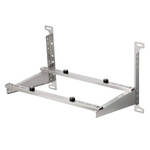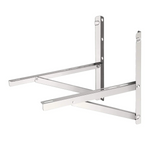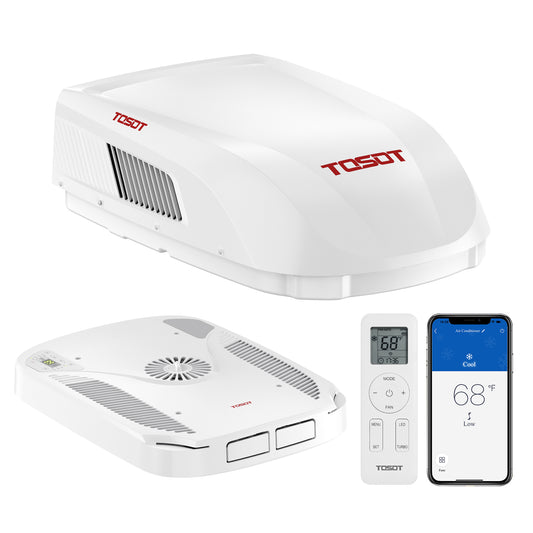
When it comes to traveling in your RV during hot summer months, having a reliable and efficient air conditioning system is crucial for a comfortable journey. With the wide variety of options available on the market, it's essential to consider several factors before making a decision. From power and size to energy efficiency, each aspect plays a vital role in selecting the perfect air conditioning system for your RV. Let's explore the key points to keep in mind when choosing an air conditioner for your RV or camper.
Click to see,
Cooling Power
One of the primary factors to consider is the power output of the air conditioning system. The power of an RV air conditioner is measured in British Thermal Units (BTUs). A higher BTU rating signifies a more powerful cooling capacity. The size of your RV and the local climate will determine the appropriate BTU rating for your air conditioner.
Generally, smaller RVs require an air conditioner with a lower BTU rating, while larger motorhomes will require more powerful units. It's essential to strike a balance to avoid overloading your RV's electrical system while ensuring adequate cooling and comfort.
Use the RV Air Conditioner Size Calculator on this website to determine the ideal BTU cooling capacity for your RV based on its cubic footage."
https://calculator.academy/rv-air-conditioner-size-calculator/
With the TOSOT GO Cool, you get a high 15,000 BTU cooling capacity and a powerful 12,000 BTU heating capacity to cover larger spaces up to 250 sq ft. For reference, 15,000 BTU is ideal for RVs from 16 to 24 feet long.
Size
The physical dimensions of the air conditioning unit are another crucial aspect to consider. RVs come in various sizes and configurations, and finding an air conditioner that fits seamlessly is essential. Measure the available space on the rooftop or designated area where the air conditioner will be installed. Consider the overall weight of the unit as well to ensure it is within your RV's weight capacity. A compact and lightweight air conditioner will not only be easier to install but also help maintain your RV's overall balance and stability.
The TOSOT Go Cool RV Air Conditioner fits standard 14.25 x 14.25-inch rooftop vent openings for easy rooftop installation.

Energey Efficiency
Energy efficiency is a significant consideration when choosing an air conditioning system for your RV. Opting for an energy-efficient unit not only helps reduce your environmental impact but also saves on electricity costs.
Look for air conditioners with high Energy Efficiency Ratios (EER) . These ratings indicate the cooling efficiency of the system, with higher values translating to better energy savings. Additionally, consider features like programmable thermostats, adjustable fan speeds, and sleep modes that further enhance energy efficiency and overall comfort.
The TOSOT Go Cool air conditioner boasts a high-efficiency EER rating of 8.5, which means it delivers optimal cooling and heating performance while consuming less energy.
Noise Level
Another factor to take into account is the noise level of the air conditioning system. RVs are meant to provide a peaceful and enjoyable travel experience, so excessive noise from your air conditioner can be disruptive. Look for units specifically designed with noise reduction features.
The TOSOT RV AC has been tested to have a noise rating of 43 dB, which is approximately 32% quieter than comparable RV air conditioners.

Installation and Maintenance
Consider the installation and maintenance requirements of the air conditioning system. Some units may require professional installation, while others can be easily installed by RV owners themselves. Additionally, inquire about the availability of installation kits and instructions to ensure a smooth and hassle-free installation process. Furthermore, look for air conditioners that are easy to clean and maintain. Removable and washable filters are convenient and help keep optimal air quality within your RV.
Please note that the TOSOT GO COOL is a ductless AC unit, meaning it is not compatible with RVs with ductwork, so keep that in mind before making your purchase. If you have a ductless RV with a standard 14.25 x 14.25-inch rooftop vent opening, the TOSOT GO can be installed yourself in as little as 20 minutes. If you have ever installed a window air conditioner in your home, the TOSOT GO RV air conditioner should be very similar to install.
Other Alternatives
Installing a Window AC in Your RV
Installing a window AC in an RV is possible, but it has pros and cons. The advantages include availability, affordability, and higher cooling capacity. However, drawbacks include structural modifications, potential leaks, weight distribution issues, lower energy efficiency, and limited compatibility with RV electrical systems.
Installing a window AC may require modifications to your RV's structure, such as cutting a hole in the wall or window. This could compromise the integrity of the RV and potentially lead to water leaks or damage. Window units also tend to be bulkier and heavier, which can affect your RV's weight distribution and overall stability.
Installing a Portable AC in Your RV
Using a portable air conditioner in an RV is another option that offers its own set of advantages and disadvantages. The primary benefit is portability, allowing you to move the unit around as needed. You could take the portable AC with you in your RV and then wheel it back into your house when your trip is over. Portable ACs are generally easy to install, requiring minimal modifications to your RV.
However, there are a few downsides to consider. Portable air conditioners take up valuable floor space inside the RV and may require venting through a window or a dedicated exhaust system. They also tend to have lower cooling capacities compared to window or rooftop units, making them more suitable for smaller RVs. Additionally, portable ACs may generate more noise due to the proximity of the compressor to the living area.
Overall, a portable air conditioner can provide convenient cooling in an RV, but careful consideration of space, venting requirements, cooling capacity, and noise levels is necessary.
Using a Fan in Your RV
Last, we have the easiest of the three alternative options to a dedicated RV air conditioner: the reliable fan. Using a standard tower fan in your RV instead of a portable or window air conditioner has its own set of pros and cons. 
The advantages of using a tower fan include affordability, simplicity, and energy efficiency. Tower fans are generally more budget-friendly compared to air conditioners, making them a cost-effective cooling solution. They are also easy to use and require no installation or modifications to your RV. Tower fans consume less energy than air conditioners, which can be beneficial for those conscious of their power usage. Additionally, tower fans provide a gentle breeze and help with air circulation inside the RV, promoting a more comfortable environment.
However, tower fans are not designed to cool the air as air conditioners do, so they may not be sufficient in extremely hot climates or during peak summer temperatures. If you rely solely on a tower fan for cooling, it may not provide the desired level of comfort in high-heat conditions. Ultimately, while a tower fan can be a cost-effective and energy-efficient solution for mild cooling needs, it may not be suitable for intense heat or hot climates where an air conditioner is necessary for effective temperature control.
Conclusion
In conclusion, choosing the right air conditioning system for your RV is essential to ensure a comfortable and enjoyable travel experience, particularly during the hot summer months. Consider factors such as power, size, energy efficiency, noise level, installation, and maintenance requirements before making a decision.
Taking into account these crucial factors, the TOSOT RV Air Conditioner is an excellent option to consider. With a cooling capacity of 13,500 BTUs, this non-ducted rooftop unit provides ample power to cool RVs up to 250 square feet in size. That’s a standard 16-24 foot RV for reference.
Its compact design ensures easy installation, while the lightweight construction adds minimal weight to your vehicle. The TOSOT RV Air Conditioner also boasts a high Energy Efficiency Ratio (EER) of 8.5, ensuring efficient cooling with minimal energy consumption. Additionally, the unit operates at a low noise level, allowing you to enjoy a peaceful environment while on the road.
To learn more about the TOSOT GO RV Air Conditioner, head over to our product page for the full list of specs and features.






